Oops They Did It Again Industry
The coal slurry spill on March 23 in Boone County was just the latest in a long list of "accidents" in our state. 5,400 gallons of slurry burst from a piping at Alpha Natural Resources' Admiral Processing Plant into Drawdy Creek, a tributary of the Coal River, which runs through the community of Peytona. Nearly three miles of the stream was turned pitch black. This prompted officials to shut downwardly the public h2o intakes for St. Albans and Lincoln County.
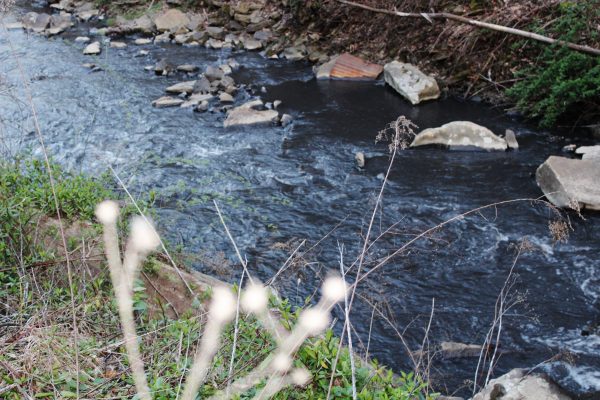
Drawdy Creek in Boone Co., WV, turned back due to coal slurry spill.
Coal slurry is the liquid by-product of "washing" the coal afterwards it is mined. Information technology'due south a toxic soup of hazardous chemicals, organic compounds, and heavy metals. Chronic exposure to metals constitute in slurry can harm virtually every role of the body. Many of these compounds are known to exist carcinogenic, neurotoxic, genotoxic, and connected to kidney illness and failure. Health problems caused by the heavy metals include intestinal lesions, neuropathy, kidney and liver failure, cancer, loftier blood pressure, brittle basic, miscarriages, and birth defects, amidst others.
Specific studies of the effects of coal slurry compounds on human jail cell tissues has found evidence that coal slurry causes cancerous proliferation, jail cell death, and damage to kidney cells. Slurry contains more fifty known organic compounds and over 20 heavy metals. The precise chemical limerick of coal slurry is largely unknown and variable.
Alpha and the WV Section of Ecology Protection rushed to protect the people from these dangerous substances past putting bales of hay in the creek, 24 hours subsequently the pipe leaked non one time, but twice, spilling, at its peak, 30 gallons per hr over 3 hours. As long every bit the water turned articulate once more, people would exist none the wiser, right? About the aforementioned fourth dimension the bales of hay went into the
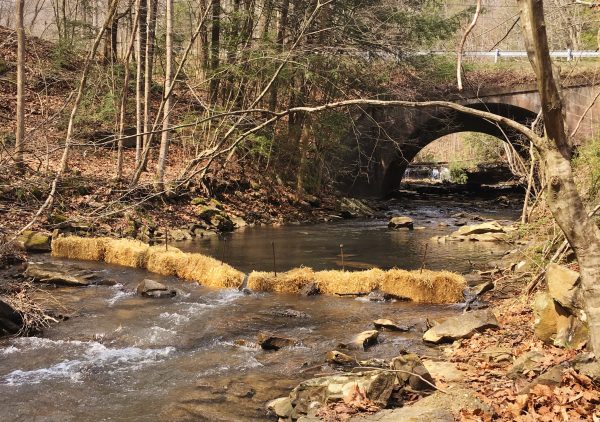
Bales of hay put beyond Drawdy Creek near Drawdy Falls Park in Boone Co. to stop the slurry spill. Photograph by Erin Brutal, Appalachian Voices
creek, the public water intakes reopened. I has to wonder, are those h2o treatment plants equipped to examination for every unmarried toxic element that is in coal slurry and have results less than a day afterwards the spill?
Information technology seems like anymore, West Virginians measure time in these disasters. Just take a look through our history and it's obvious that nosotros have had more than our share of incidents; the bulk at the hands of the fossil fuel and chemical industries. However, information technology seems every time something happens, these companies claim it is simply an "accident" or, more famously, "an human activity of God." When we reported about the Peytona spill on social media, a lot of pro-industry folks made comments similar "information technology was merely an accident, y'all should go out it alone." Simply how many more "accidents" have to happen before we wise upward?
The surprising matter is West Virginians seem to be getting increasingly numb to these so-chosen "accidents." Seems similar whenever something happens, we just shrug our shoulders and go almost our business organization. Local media may talk nearly it for a 24-hour interval or two, then it just seems to disappear. Could exist worse, right? Estimate we should be glad what happened in Peytona was but a spill, and not a repeat of the slurry impoundment failure that caused the Buffalo Creek Disaster that killed 125 and left over
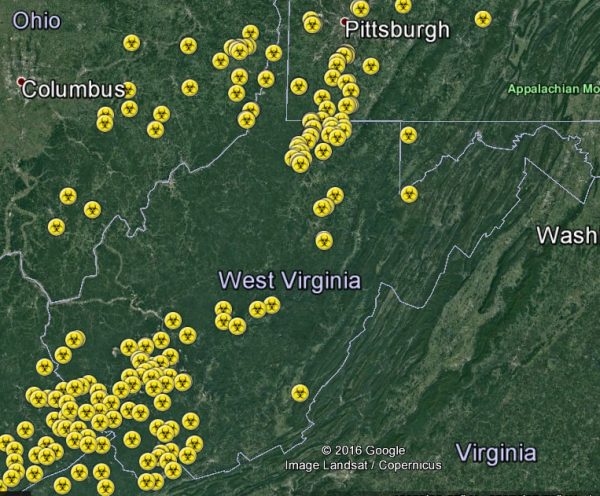
Google Earth image representing Coal Slurry Impoundments just in WV and surrounding areas alone. Each xanthous circle is a slurry impoundment.
4,000 homeless. The creek just turned black in Peytona—maybe nosotros should count our blessings?
It's of import to annotation that in that location is really no need for slurry. There is a "dry filter-press" method that leaves the waste material every bit solid materials. Nonetheless, coal companies run across this process equally more expensive, then instead they just get out these massive toxic lakes in our communities.
There are more than 100 of these lakes, a.k.a. slurry impoundments, in West Virginia alone. Most are much bigger than the one at Buffalo Creek. Information technology's merely a affair of time before the next one "leaks", or worse. The Brushy Fork Impoundment in Raleigh Canton is taller than the Hoover Dam and holds 9+
billion gallons of toxic coal slurry. These impoundments are nothing more than unlined earthen dams that accept the potential to fail at any time. I'thou sure when that time comes, it will be considered but another "blow."
It has simply been three years since the MCHM chemical spill that left 300,000 people in fundamental West Virginia without h2o. While it is truthful the MCHM leaked from a tank at Freedom Industries (a chemical storage facility), contrary to one-time Governor Tomblin's exclamations that this had nil to do with coal, this was a chemical just used by the coal industry to "wash" coal for market.
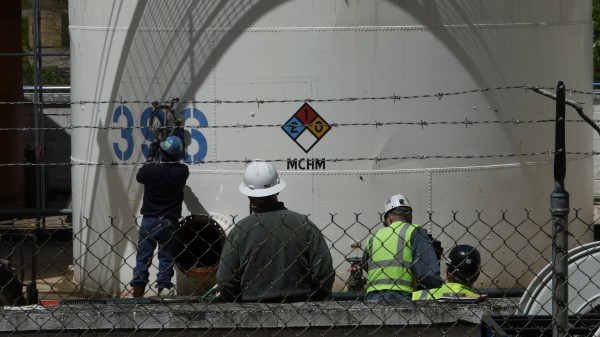
Chemic storage tank containing MCHM
Terminal June, while on a bout of the former Liberty Industries site, not ane, but ii WV DEP officials commented that since there was such a modest number of people on the bout, the issue must be "finally dying downwardly." I gauge since they've torn down the tanks, it'southward out of sight out of mind for the people.
Even during the MCHM crunch, people seemed to forget that just months before, in September, a chemical called DT-50-D turned an entire river white in Boone County when it flare-up from its container at a coal prep plant endemic by the now not-existent Patriot Coal. Then at that place was another spill of over 100,000 gallons of coal slurry from a site too owned past Patriot into a tributary of the Kanawha River a month afterwards the MCHM spill.
Nothing to see here folks, just move on. In that location take also been ii more MCHM spills following the Elk River spill. Ane in Marmet, WV, only a month later the Freedom incident and i in February of this yr at the Mammoth Coal Prep Plant that leaked into the Kanawha River. While it's true these 2 were no where the size of the January 2022 spill, they still happened. More "accidents." How many more have happened that nosotros don't know about?
I guess information technology was also just an blow that coal slurry got into the ground water sources for the towns of Rawl and Prenter, making people in that location sick. This was due to a technique concocted by Alpha's predecessor, Massey Free energy, to pump coal slurry into abandoned undercover mine works. Hey, out of sight out of mind.
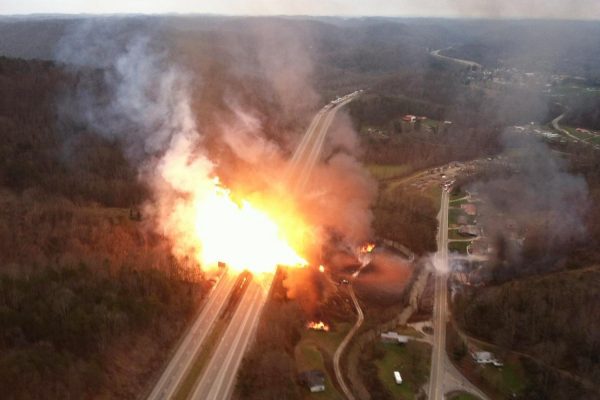
A gas pipeline explosion rocked an area along I-77 near Sissonville, WV, December. xi, 2012.
At present with up to 16 or more proposed pipelines in and effectually West Virginia, I suppose nosotros should also forget the gas pipeline explosion at Sissonville that acquired I-77 to close down? That will never happen once again, right? "Accidents" related to natural gas, pipelines, and fracking are not limited to just this incident either. Also, let's non exit out that time the oil railroad train exploded in Fayette County.
Then add in all the coal mine "accidents" like UBB, Sago, Aracoma, Farmington, Monongah, and so on. Those are but some of the major mine disasters in our history, not counting things like roof falls in mines, etc. The list of "accidents" goes on and on. That'due south merely in W Virginia. If you add in all the "accidents" in the Appalachian region (for example the Martin County, KY, slurry disaster or the time a bedrock from a a mine site and killed a iii-year old while he slept in his bed in VA, or the Knuckles Energy coal ash spill) the number grows exponentially. I don't know about you, but that certain does seem like a lot of "accidents" caused by industries.
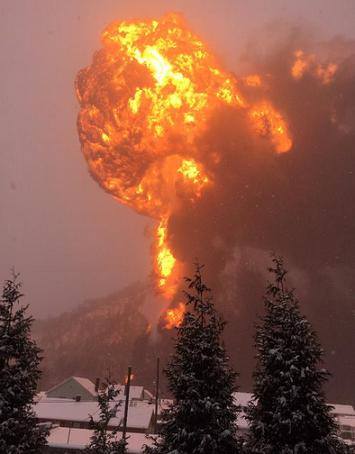
Fireball from the Bakken Oil "Bomb Train" derailment in Fayette Co., WV.
Now that we take a coal businesswoman every bit Governor – who appointed an ex-coal executive as head of WV DEP – should we expect more to happen? The DEP already fails in enforcement. Legislatures in D.C. and Charleston have worked years to dismantle regulations meant to forestall these things from happening. At present, with Trump's attack on regulations and the WV Legislature's attempts to weaken water quality standards, we are the ones at chance. Every endeavour to dismantle the EPA leaves us vulnerable. It's non a question of if, merely when another "accident" will happen.
I approximate equally long every bit these companies keep waving the imprint of jobs, we only let it happen. To them, these "accidents" are the cost of doing business. It seems to me that every time i of these companies gives us a black heart, we continue to praise them. They become rewarded for negligence. It'southward a lot like battered spouse syndrome. They hurt us then promise never to exercise it once more, simply they do, and we do nothing. Should we really only forgive and forget? Or, should movement away from an economy that revolves around companies that have then many "accidents"? Isn't enough, enough?
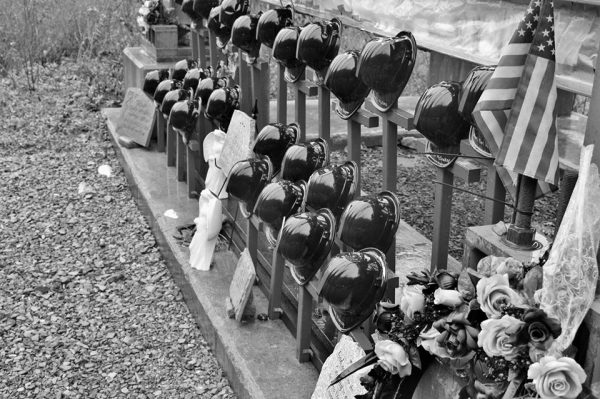
The memorial at the Upper Large Branch (UBB) mine site where 29 were killed. The virtually recent "big" mining "accident" that toll the lives of coal miners. How many more than have to dice?
Source: https://ohvec.org/oops-industry-accidents/
0 Response to "Oops They Did It Again Industry"
Post a Comment